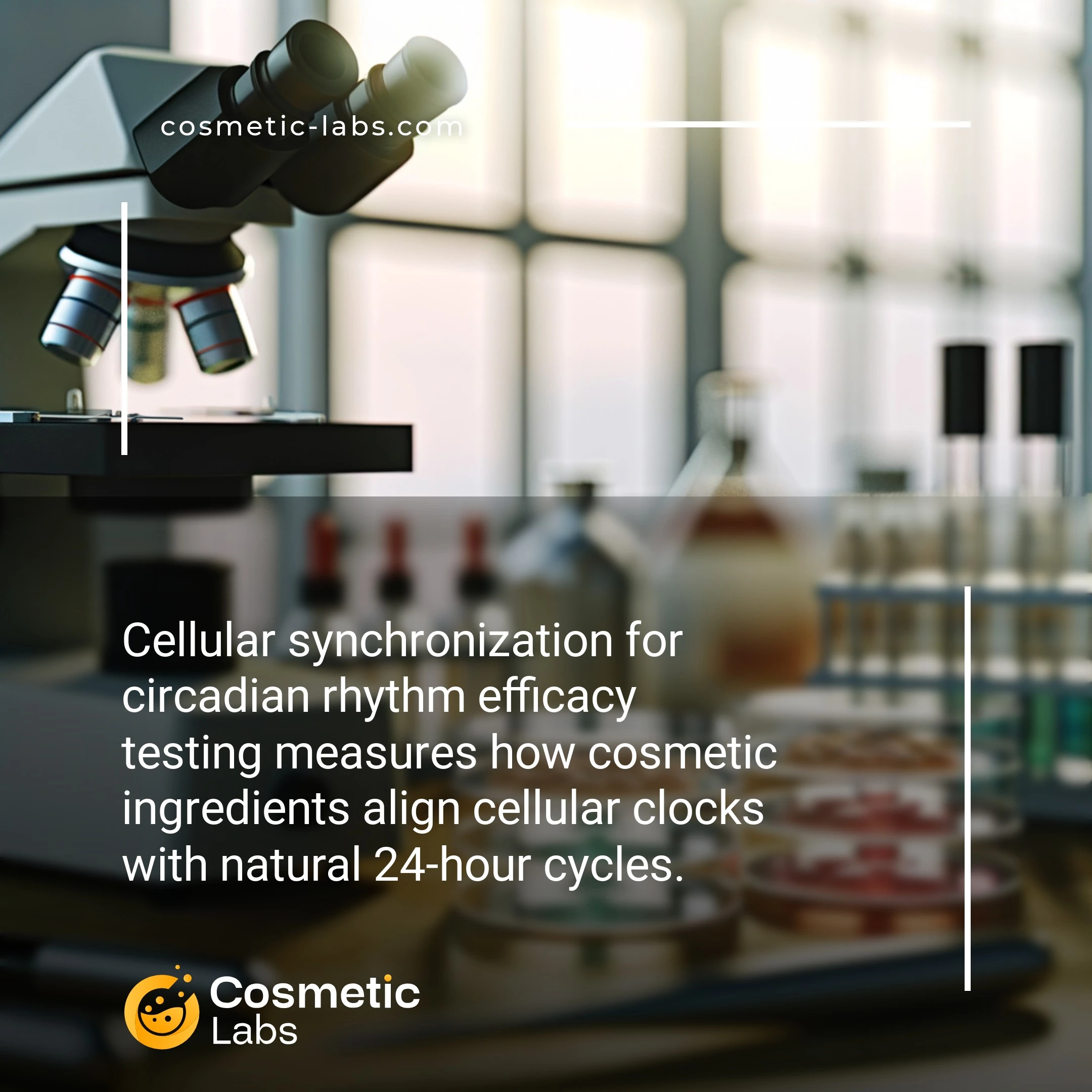Circadian Rhythm Testing Labs for Beauty Product Efficacy

What is Cellular synchronization?
Cellular synchronization for circadian rhythm efficacy testing is a laboratory service that measures how cosmetic ingredients affect cellular clock mechanisms in skin cells. Our partner labs use synchronized cell cultures exposed to light-dark cycles to test whether your anti-aging serums or sleep-promoting skincare actually influence the skin’s natural 24-hour repair processes. This testing reveals if ingredients like melatonin or peptides can genuinely reset disrupted cellular rhythms, providing scientific validation for circadian-based beauty claims.
Why do you need this service?
Beauty brands leverage cellular synchronization testing to validate anti-aging serums and night repair formulations that claim to work with natural skin renewal cycles. Our partner labs measure how active ingredients like retinoids, peptides, and botanical extracts influence cellular clock proteins in skin cells, delivering concrete efficacy data that supports marketing claims about overnight skin repair and circadian-optimized skincare routines.
Who provides Cellular synchronization services?
All cosmetic labs providing Cellular synchronization services
There is no company providing these services at the moment.
Cellular Synchronization Testing for Circadian Rhythm Efficacy
Cellular synchronization testing measures how cosmetic ingredients influence biological clock mechanisms at the cellular level. This advanced testing method validates claims about products designed to support natural skin rhythms and nighttime repair processes.
Molecular Clock Gene Expression Analysis
Labs use specialized cell culture models to track circadian gene expression patterns after ingredient exposure. Testing typically involves human skin cells synchronized to 24-hour light-dark cycles, then treated with your formulation components.
Key measurements include:
- Clock gene oscillation amplitude (CLOCK, BMAL1, PER, CRY genes)
- Phase shift detection in cellular rhythms
- Metabolic synchronization markers
- DNA repair pathway activation timing
Results help validate marketing claims about “night repair” or “circadian support” formulations with quantifiable molecular data.
Chronobiology Biomarker Validation
Testing services evaluate how ingredients affect cellular processes that follow natural daily rhythms. Labs measure protein synthesis rates, antioxidant enzyme activity, and cellular repair mechanisms across different time points.
Standard protocols include:
- 24-48 hour synchronized cell culture preparation
- Timed ingredient application at specific circadian phases
- Multi-timepoint sample collection every 4-6 hours
- Quantitative analysis of rhythm-dependent biomarkers
This data supports regulatory submissions and provides scientific backing for chronocosmetic product positioning. Connect with specialized labs on our platform to discuss your circadian rhythm testing requirements and timeline.
Applications of Cellular Synchronization for Circadian Rhythm Efficacy Testing
Beauty brands use cellular synchronization for circadian rhythm efficacy testing to validate time-dependent ingredient performance and optimize product formulations for specific application windows.
Anti-Aging Product Development
Labs synchronize skin cell cultures using temperature shifts or serum shock protocols to mimic natural circadian cycles. This testing reveals how retinoids, peptides, and growth factors perform during different phases of the cellular clock. Teams measure DNA repair activity, collagen synthesis rates, and antioxidant enzyme expression across 24-hour cycles.
Results show peak repair activity occurs during simulated nighttime hours, while barrier function restoration peaks in early morning phases. Brands use this data to formulate night creams with higher active concentrations and morning products focused on protection.
| Testing Phase | Cellular Activity Measured | Optimal Product Application |
|---|---|---|
| Circadian Peak (CT 18-24) | DNA repair, autophagy | Night treatments, retinoids |
| Circadian Trough (CT 6-12) | Barrier synthesis, antioxidant defense | Morning serums, sunscreens |
| Transition Phases | Cell division, protein synthesis | Multi-step routines |
Chronocosmetic Ingredient Validation
Cosmetic labs test time-release delivery systems and circadian-active compounds using synchronized cell models. Researchers expose cultures to melatonin, cortisol mimetics, or clock gene modulators while monitoring cellular responses. Testing protocols measure gene expression changes, metabolic shifts, and stress response activation.
This approach validates ingredients like bakuchiol for evening use and niacinamide for morning application. Labs track how ingredient timing affects cellular uptake and biological activity over 48-72 hour test periods. Data supports marketing claims about optimal application timing and product efficacy windows.
Ready to validate your chronocosmetic formulations? Connect with specialized labs on our platform that offer cellular synchronization testing services for circadian rhythm research.
